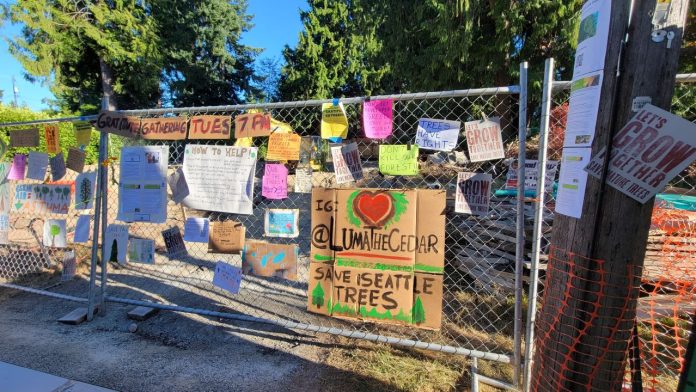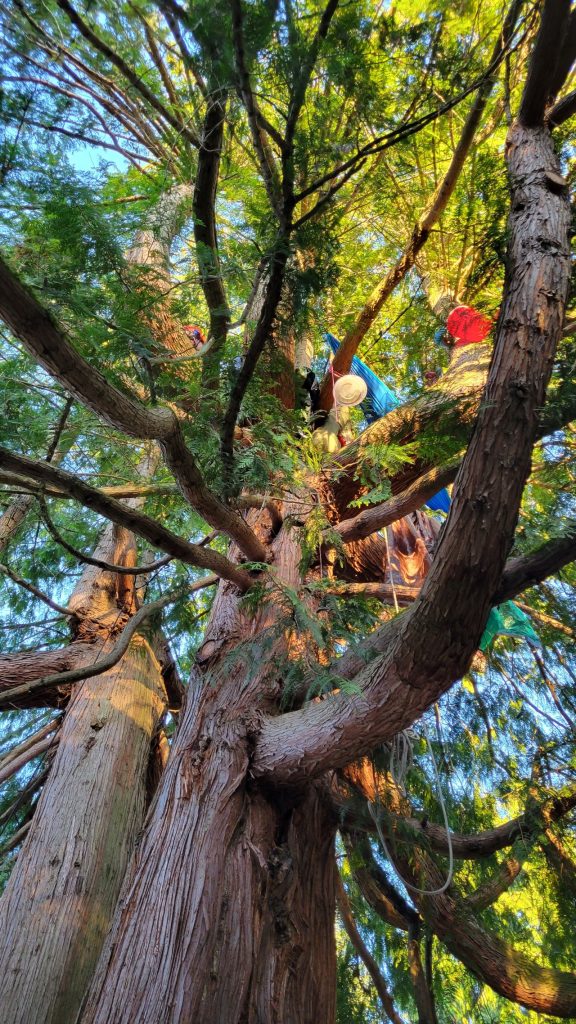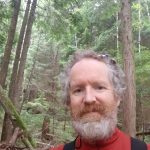
Tree activists rally, seeking to save a giant red cedar in Wedgwood from the ax.
Luma is a healthy old growth Western red cedar in the Wedgwood neighborhood of Seattle with cultural and ecological significance, but it’s under threat of destruction. Luma is currently under an order for removal by the Seattle Department of Construction and Inspections (SDCI) so that a developer – Legacy Group Capital based in Bellevue – can build six market-rate houses. Unsurprisingly, people living in the neighborhood are trying to prevent this, with activists currently camped out 40 feet above ground in the tree — halfway up the 80-foot tree.
Some attempt to make the case that people speaking out against ecologically destructive development are anti-density ‘Not In My Backyard’ (NIMBY) activists and don’t care about housing justice, but that argument is plain false. Urban forest and climate activists widely recognize the importance of affordable housing, and rightly point out that loss of urban tree cover affects us all.
In Luma’s case, an independent architect recently concluded that the site could have been designed differently to preserve the tree while still allowing the six homes to be built. While Luma is in a relatively canopy-rich area of North Seattle, cutting it down would set a bad precedent that threatens large trees across the city. Some neighborhoods have precious few large trees to spare.
Lack of tree cover disproportionately impacts lower income, immigrant, and communities of color living in neighborhoods like South Park, Georgetown, and Rainier Valley. South Park’s canopy cover is just 10% compared to Los Angeles which is 18%. These neighborhoods suffer from much higher rates of asthma and chronic disease. Shaded surfaces may be as much as 20 to 45 degrees Fahrenheit cooler than peak surface temperature of unshaded materials, the difference between being comfortable and a 9-1-1 call from a person suffering from heat stroke or skin burns.

The tree ordinance passed in May by the Seattle City Council and signed by Mayor Bruce Harrell is deeply disappointing to those of us working for climate justice and averting the worst case scenarios of climate breakdown. Those new regulations take effect on August 1, but they do not appear to offer help of saving trees like Luma.
What forces shaped the passage of this bill? Investigate West’s Eric Scigliano has written an insightful piece showing how developers shaped the bill and won key concessions, including lot-splitting and guaranteed lot coverage provisions that have cleared the way for Luma’s removal.
A false narrative creating an either-or dichotomy emerged that pitted urban density and affordable housing concerns against ecologically sound tree management. Faced with these optics, the City Council rushed to a vote without allowing adequate input from independent urban foresters.
It seems that builders often rely on cookie cutter plans and don’t like to be bothered with complicated details and market forces make it more profitable just to scrape the lot as quickly as possible. Another factor is the revolving door for personnel between the development community and City Hall.
An archeologist in consultation with the Snoqualmie Tribe recently declared Luma a “culturally modified tree” based at least in part by the shape of one of the tree limbs and that of a neighboring tree. The trees were intentionally bent when young so that as they grew, they would act as markers for land travelers, back when the only roads were mere footpaths through the forest. Luma is estimated to be more than 150 years old, 88 inches in circumference, predates White settlement of this area and was cared for by Indigenous people who knew (and still know) how to live in balance with the land, the water, the Earth, and spirit.
What can be done?
- Call and write to the Mayor and ask him to stay the execution of this magnificent tree.
- Call and write your City Council (council@seattle.gov) representative and ask them to revise the tree ordinance so that it doesn’t allow developers to routinely cut exceptional trees like Luma. Ask them to fill the vacant Urban Foresters office with someone whose allegiance is to science and planning for seven generations, not industry wish lists.

Jordan Van Voast (Guest Contributor)
Jordan Van Voast is a community acupuncturist, president of Dharma Friendship Foundation and a founding member ofSeattle Cruise Control, a grassroots advocacy group dedicated to highlighting the harmful impacts of cruise ships to labor and the environment. He lives in South Seattle.
